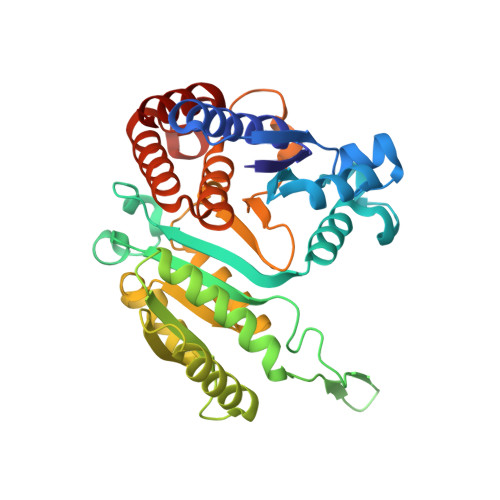Design, X-ray crystallography, molecular modelling and thermal stability studies of mutant enzymes at site 172 of 3-isopropylmalate dehydrogenase from Thermus thermophilus.
Qu, C., Akanuma, S., Tanaka, N., Moriyama, H., Oshima, T.(2001) Acta Crystallogr D Biol Crystallogr 57: 225-232
- PubMed: 11173468
- DOI: https://doi.org/10.1107/s0907444900017388
- Primary Citation of Related Structures:
1G2U, 1GC8, 1GC9 - PubMed Abstract:
The relationship between the structure and the thermostability of the 3-isopropylmalate dehydrogenase from Thermus thermophilus was studied by site-directed mutation of a single Ala residue located at the domain interface. The crystal structures of three mutant enzymes, replacing Ala172 with Gly, Val and Phe, were successfully determined at 2.3, 2.2 and 2.5 A resolution, respectively. Substitution of Ala172 by relatively 'short' residues (Gly, Val or Ile) enlarges or narrows the cavity in the vicinity of the C(beta) atom of Ala172 and the thermostablity of the enzyme shows a good correlation with the hydrophobicity of the substituted residues. Substitution of Ala172 by the 'longer' residues Leu or Phe causes a rearrangement of the domain structure, which leads to a higher thermostability of the enzymes than that expected from the hydrophobicity of the substituted residues. Mutation of Ala172 to negatively charged residues gave an unexpected result: the melting temperature of the Asp mutant enzyme was reduced by 2.7 K while that of the Glu mutant increased by 1.8 K. Molecular-modelling studies indicated that the glutamate side chain was sufficiently long that it did not act as a buried charge as did the aspartate, but instead protruded to the outside of the hydrophobic cavity and contributed to the stability of the enzyme by enhancing the packing of the local side chains and forming an extra salt bridge with the side chain of Lys175.
Organizational Affiliation:
Department of Life Science, Graduate School of Bioscience and Biotechnology, Tokyo Institute of Technology, Nagatsuta 4259, Yokohama 226-8501, Japan.














